- Details
- Published on Tuesday, 19 August 2014 22:13
Vuelta a España 2014 Overview
23rd August to 14th September, 3,185km
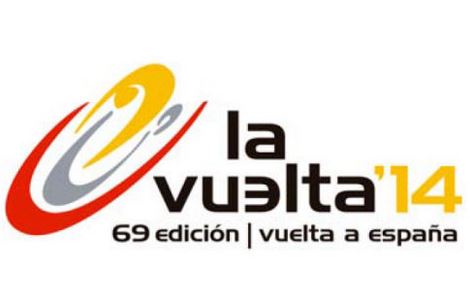
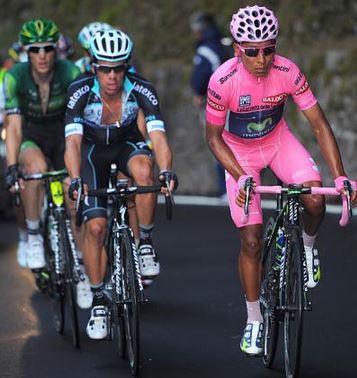
Giro Champion Quintana has warmed up for the race with a very good win in the Vuelta Burgos just this weekend. Chris Froome has been training really hard since and he probably has kept much of his condition seeing as it was a wrist injury rather than a leg one. Contador has at various times since leaving the TDF said that he was doing the Vuelta/not doing the Vuelta, was recovering well/suffered a big set back etc. with a lot of contradictions coming from him and the team. Just this week then he announced that he was definitely going to be doing it and there have been stories doing the rounds that he has been spotted training around Lugano, where he lives, training a lot harder than he or the team have been revealing.
The 69th Vuelta a España starts in the South-western corner of Spain in Jerez de la Frontera, a decision some questioned as to how they could afford to bid for a stage start, given that the town has the largest debt of any city in Spain outside of Madrid (they owe over €744m!). For the first time since 1993 the race will finish outside of Madrid, finishing, as it did in 1993, with a time trial in Santiago de Compostela.
The route for the 2014 Vuelta is hilly of course - it wouldn't be the Vuelta without a large amount of mountains to get over, but in comparison to recent years it's not the hardest of editions. There are eight summit finishes, which is four fewer than in 2013, but there are another five stages which are classified as hilly which leaves 5 flat stages for the sprinters to do battle on.
What it does have though is plenty of time trialling kilometres. If you include the opening Team Time Trial there are three time trials in total covering 59kms in all. In summary, the race is made up of:
- 5 Flat stages
- 5 Hilly stages
- 8 Mountain stages with summit finishes
- 2 Individual Time Trials
- 1 Team Time Trial
- 2 Rest days
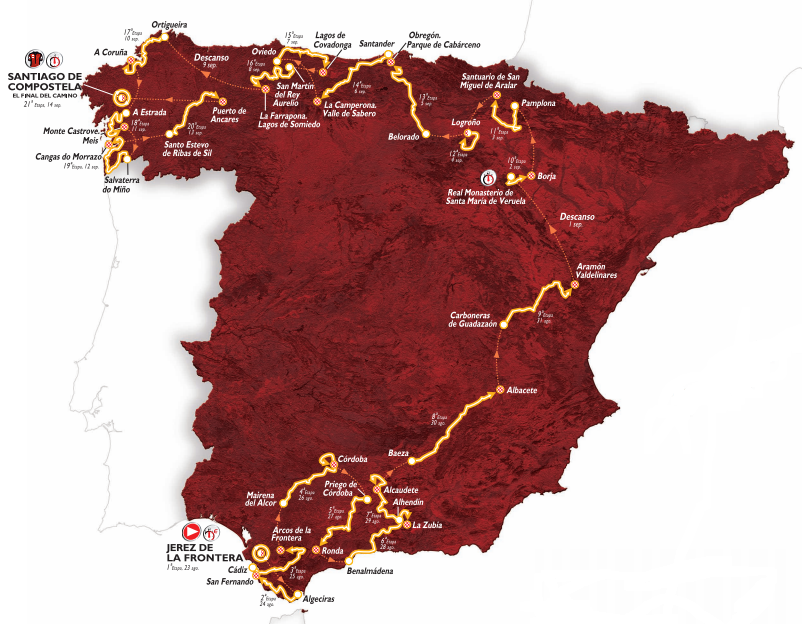
What we are not going to see this year though is a trip to the Pyreneesor a trip in to Andorra or France, something which is quite unusual for the Vuelta these days. They have tried to avoid long transfers this year and the organisers have estimated they have shaved 2000kms off the transfers from last year!
Time bonuses make a reappearance again this year and they could be crucial if it does end up being as tight at the top as it looks like it could be given the quality of the field lining up.
The Route - A quick synopsis
The race starts with a 12.6km TTT in the European City of Wine 2014, Jerez and it's a dead flat but very technical course. Let's hope we don't see a big incident like we saw in Belfast in the TTT of the Giro when Dan Martin crashed out.
Stage 2 is a flat run along the coast where the winds could be the main feature of the day. They hit a 3rd category climb after just 10kms but the rest of the stage is almost dead flat as they head north-east from Algeciras to San Fernando over 174kms. Stage 3 sees them head inland in to the Sierra de Grazalema and the first mountains of the Vuelta, with 4 Cat 3 climbs on the 197.8km route. The final two kilometres are uphill and it should see the puncheurs/climbers battle it out, although it also looks a good stage for a breakaway.
Stage 4 sees them cover a short stage from Mairena Del Alcor to Córdoba which is mostly flat up until 106km in when they hit a Cat 3 climb, then with 130km gone they hit the first Cat 2 climb of the race, an 8km drag up to Alto Del Catorce por Ciento which should see things split up with just 25kms to go to the line.
 Stage 5 is a bit non-descript with a flat-ish run to what should be a sprint finish. Stage 6 is the first real big test of the race with a 167km run which takes them from Benalmadena to La Zubia. First up is a Cat 2 climb to Alto de Zaffaraya, a 12km hill, that actually stretches on for about another 8kms after the KOM. Then after rolling through a Cat 3 climb shortly after they charge towards the finish in La Zubia and the finishing climb to Alto Cumbres Verdes. The final climb averages 7.8% but hits a max of 12.8%. It should give us the first glimpse of who may not have the legs to win this race.
Stage 5 is a bit non-descript with a flat-ish run to what should be a sprint finish. Stage 6 is the first real big test of the race with a 167km run which takes them from Benalmadena to La Zubia. First up is a Cat 2 climb to Alto de Zaffaraya, a 12km hill, that actually stretches on for about another 8kms after the KOM. Then after rolling through a Cat 3 climb shortly after they charge towards the finish in La Zubia and the finishing climb to Alto Cumbres Verdes. The final climb averages 7.8% but hits a max of 12.8%. It should give us the first glimpse of who may not have the legs to win this race.
Stage 7 is another of the 'hilly' stages with a 169km run from Alhendin to Alcaudete that includes a Cat 2 and a Cat 3 climb and an uphill finish that is uphill for 4 of the last 5 kilometres. It could be a stage for a breakaway winner or if not look for the likes of Valverde or Rodriguez.
Stage 8 is the longest stage so far at 207km and it is a day for the sprinters with an almost pan-flat profile. The winds around Albacete could play a part in the day's action though. Stage 9 sees them hit the mountains again, with the 185km route taking them to a summit finish at Aramón Valdelinares. The 8km climb averages 6.6% with parts at 8.5% inside the last 2kms. The last kilometre averages only 2.5% so it's not such a difficult finishing run.
Stage 10 sees them move further north after a transfer to Real Monasterio de Santa María de Veruela for the first individual TT of the race. The first 11km of the 36.7km test are all uphill to a Cat 3 climb, then it's downhill for the remaining 25km to the line.
Stage 11 heads to the community of Navarra for a tough little stage over 153.4km. There's a little appetiser with a Cat 3 climb first after 100km but the main event is the Cat 1 climb to the finish at Santuario de San Miguel de Aralar. 9.9kms long at an average of 7.5% with a max of 14% it is sure to see some time gaps appear again between the contenders and the also-rans.
Stage 12 is a circuit race of eight laps around the city of Logroño, which should end in a sprint. In 2012 this same stage was won in a sprint by John Degenkolb. Stage 13 takes them in to Cantabria for a 188km run towards to the coast to Obregón. Parque de Cabárceno. The first 80kms are downhill to flat until they start up the Cat 3 climb which they crest after 110km. From there its up and down over two more climbs before the run to the finish. The road kicks up for about 800m with 2.5kms to go but the last 500m or so are slightly downhill so if someone can get a gap up the climb they might just hang on.
Stage 14 is a hard stage, a perfect stage for a Saturday TV audience! It's a long stage at 200.8kms and it includes a Cat 2 climb after 77kms, the long 33km drag up to the Cat 1 Puerto de San Glorio after 131kms and then after 69kms of flat to downhill roads they hit the final kick up to the finish in La Camperona. Valle de Sabero at a height of 1600m. The last two kilometres are particularly brutal with sections hitting 14.4%, 15% and even as high as 19.5%.
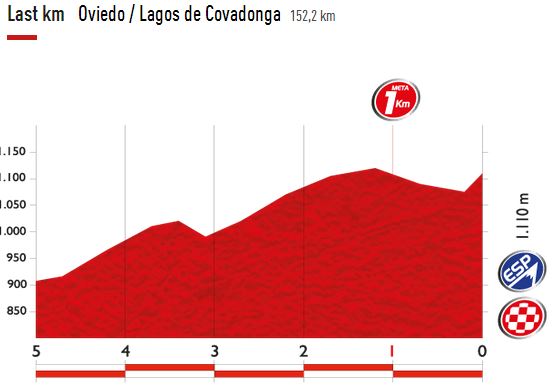
With the second rest day over they tackle stage 16, the queen stage of the race and a particularly savage day in the saddle. 160kms to the finish in La Farrapona. Lagos de Somiedo takes them over three Cat 1s and a Cat 2 climb before the final climb to the finish, another Cat 1 climb which averages 6.2% over 16.5kms
Stage 17 is the final chance for the sprinters in this race with a flat 190km run to the town of A Coruña. Stage 18 is a mostly flat stage where they cover 120kms before arriving in the city of Pontevedra. From there they go out on a circuit which sees them pass over the Alto Monte Castrove after 133km for the first time and then climb it again to the finish after 157kms. The last 700m are downhill though so if a small group crests the KOM together they will battle it out in a sprint to the line.
Stage 19 looks on paper like it could be a sprinters finish but that Cat 2 climb comes just 19kms from the finish and with an average gradient of 8.4% over the 4.7kms we are sure to see most of the climbers go out the back door and a select group of GC men and puncheurs fight out the finish (but don't rule out Degenkolb if he makes it to the race).
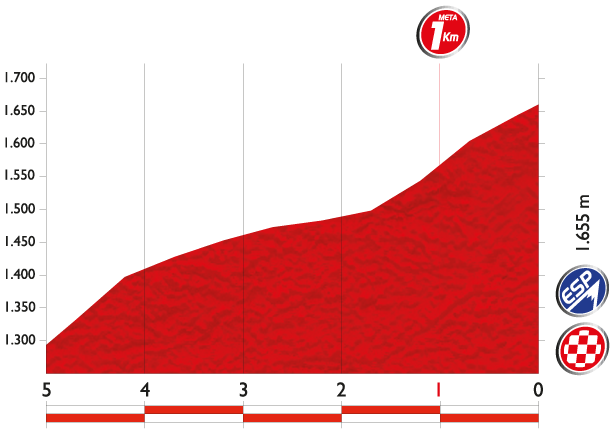 Stage 20, the penultimate stage, could the last hurrah for anyone who is still fighting for a top finishing position or possibly even overall victory. A hard stage over 185.6kms has an up and down profile for the whole day with three uncategorised climb, a Cat 3, 2 and 1 and finishing on the 'Especiale' climb to Puerto de Ancares. This is a leg breaker which is nearly 13kms long and averages 8.7%, maxing out around 18%. The steepest parts come about 4-5kms in to the climb But there are still sections at 12% and 8% inside the last kilometre.
Stage 20, the penultimate stage, could the last hurrah for anyone who is still fighting for a top finishing position or possibly even overall victory. A hard stage over 185.6kms has an up and down profile for the whole day with three uncategorised climb, a Cat 3, 2 and 1 and finishing on the 'Especiale' climb to Puerto de Ancares. This is a leg breaker which is nearly 13kms long and averages 8.7%, maxing out around 18%. The steepest parts come about 4-5kms in to the climb But there are still sections at 12% and 8% inside the last kilometre.
Stage 21, the final stage is a 9.7km dead flat time trial, which is unlikely to make much difference to the overall GC as most of the main men should be finishing pretty close to one another. There could be one or two top 10 places decided but the final showdown probably will just be a procession for whoever is in the leader's red jersey.
It is almost certainly going to be a battle between the climbers, no question about that, but then again as we saw in the TDF there is nothing certain in cycling! Quintana is the bookies 5/4 favourite, followed closely by 15/8 Froome with a jump up to Rodriguez and Contador around 10/1 then another jump to around 25-33/1 for Uran, Valverde, Aru and Horner. It's going to be a fantastic battle and one that's very hard to call a winner from with a great deal of conviction! We could see another 80/1 shock like last year with Chris Horner!
Full analysis of the contenders and possible race outcome to come, as are all the best bets for the jerseys and a selection of the best bets from the specials markets. To gain full access to all of my previews for the duration of the Vuelta you will need to subscribe, subscription is just £10.50 for the entire Vuelta, or just 50p per stage!
Click here to subscribe now in plenty of time for the start, the overall preview should be live and ready by Friday night, the 22nd August.








